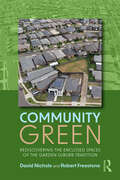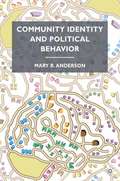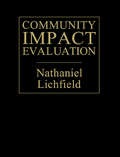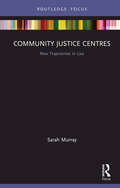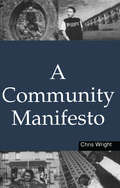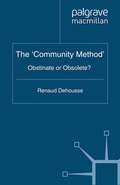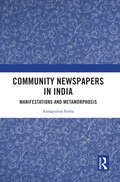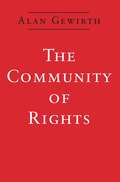- Table View
- List View
Community Green: Rediscovering the Enclosed Spaces of the Garden Suburb Tradition
by David Nichols Robert FreestoneNeighbourhood open space ranks highly as a key component in suburban liveability assessments, originating from the development of urban planning as a profession and the proliferation of the garden suburb. Community Green uniquely connects the past, present and future of planning for small open spaces around the narrative of internal reserves.The distinctive planned spaces are typically enclosed on every side, hidden within residential blocks, serving as local pocket parks and reflecting the evolving values of community life from the garden city movement to contemporary new urbanism. This book resuscitates the enclosed, almost secretive reserve from history as a distinctive form of local open space whose problems and potentialities are relevant to many other green community spaces. In so doing, it opens up even wider connections between localism and globalism, the past and the future, and for connecting community initiatives to broader global challenges of cohesion, health, food, and climate change. This fully illustrated book charts the outcomes and implications of this evolution across several continents, injecting human stories of civic initiatives, struggles and triumphs along the way.Community Green will be of interest to a wide readership interested in studying, managing and improving the quality of all small open spaces in the urban landscape.
Community Green: Rediscovering the Enclosed Spaces of the Garden Suburb Tradition
by David Nichols Robert FreestoneNeighbourhood open space ranks highly as a key component in suburban liveability assessments, originating from the development of urban planning as a profession and the proliferation of the garden suburb. Community Green uniquely connects the past, present and future of planning for small open spaces around the narrative of internal reserves.The distinctive planned spaces are typically enclosed on every side, hidden within residential blocks, serving as local pocket parks and reflecting the evolving values of community life from the garden city movement to contemporary new urbanism. This book resuscitates the enclosed, almost secretive reserve from history as a distinctive form of local open space whose problems and potentialities are relevant to many other green community spaces. In so doing, it opens up even wider connections between localism and globalism, the past and the future, and for connecting community initiatives to broader global challenges of cohesion, health, food, and climate change. This fully illustrated book charts the outcomes and implications of this evolution across several continents, injecting human stories of civic initiatives, struggles and triumphs along the way.Community Green will be of interest to a wide readership interested in studying, managing and improving the quality of all small open spaces in the urban landscape.
Community Health Advocacy
by Sana Loue Linda S. Lloyd Daniel J. O'SheaThis text provides a foundation for the initiation of advocacy efforts and for the evaluation of their success and includes topics such as: specific strategies, grassroots advocacy efforts, formation and development of coalitions, advocacy efforts in legislatures, administrative agencies, court, and the media. It is of interest to public and urban health workers, social workers, community organizers, and legislators.
A Community Health Approach to the Assessment of Infants and their Parents: The CARE Programme
by Kevin D. Browne Jo Douglas Catherine Hamilton-Giachritsis Jean HegartyThis book is a practical guide to the CARE programme, a home visiting programme that aims to assess infants? growth, development and psycho-social transitions in their first year of life and that together with the Index of Need checklist aims to engage parents in risk assessment. It provides evidence-based research for the programme, and gives clinical examples of how to use the assessment tools (including the Index of Need) and how to work with parents. The authors take a ?partnership with parents? approach throughout, while bearing in mind the practical workload issues that practitioners face.
Community Health Care (Nursing Times Open Learning Texts)
by Kate Brown Claire JohnstonThe material in this module provides learners with a comprehensive introduction to community health nursing. Through the interactive text, learners will explore the complexities of nursing in the community, the function of the primary health care team, and develop a profile of the community in which their clients live.
Community Identity and Political Behavior
by M. AndersonThe focus of this book is on how community comes to influence political behaviour; it takes an interdisciplinary approach blending the fields of community psychology, sociology, and political science.
Community Impact Evaluation: Principles And Practice
by Nathaniel LichfieldThis is a work summarizing in one volume the pioneering approach of the author to public-interest decision-taking in the field of urban & regional planning. This book is aimed at students, researchers and professionals in planning. Nathaniel Lichfield first introduced in his "Economics of Planned Development" the concept that, in any use and development of land, the traditional "development balance sheet" of the developers needed to be accompanied by a "planning balance sheet" prepared by the planning officer or planning authority. Over the forty years since this work was published, the author has brought to the operational level the "planning balance sheet", with many case studies, primarily for consultancy purposes. The present title reflects the incorporation during the 1970s of the then emerging field of environmental impact assessment.
Community Impact Evaluation: Principles And Practice
by Nathaniel LichfieldThis is a work summarizing in one volume the pioneering approach of the author to public-interest decision-taking in the field of urban & regional planning. This book is aimed at students, researchers and professionals in planning. Nathaniel Lichfield first introduced in his "Economics of Planned Development" the concept that, in any use and development of land, the traditional "development balance sheet" of the developers needed to be accompanied by a "planning balance sheet" prepared by the planning officer or planning authority. Over the forty years since this work was published, the author has brought to the operational level the "planning balance sheet", with many case studies, primarily for consultancy purposes. The present title reflects the incorporation during the 1970s of the then emerging field of environmental impact assessment.
Community Indicators Measuring Systems (Urban and Regional Planning and Development Series)
by Rhonda PhillipsCommunity indicators measuring systems represent a mechanism to improve monitoring and evaluation in planning, incorporating citizen involvement and participation. They reflect the interplay between social, environmental and economic factors affecting a region's or community's well-being, and, as such, can be extremely valuable to planners and developers. Yet, little research has been conducted on their efficacy. This book provides a comprehensive review of how community development indicators evolved and examines their interplay with planning and development. It questions how we adequately measure concepts associated with indicators systems and whether these systems are sustainable and can best evolve. In doing so, the book allows a better understanding of the theoretical underpinnings of community indicators measuring systems, as well as how best to design and implement them.
Community Indicators Measuring Systems (Urban and Regional Planning and Development Series)
by Rhonda PhillipsCommunity indicators measuring systems represent a mechanism to improve monitoring and evaluation in planning, incorporating citizen involvement and participation. They reflect the interplay between social, environmental and economic factors affecting a region's or community's well-being, and, as such, can be extremely valuable to planners and developers. Yet, little research has been conducted on their efficacy. This book provides a comprehensive review of how community development indicators evolved and examines their interplay with planning and development. It questions how we adequately measure concepts associated with indicators systems and whether these systems are sustainable and can best evolve. In doing so, the book allows a better understanding of the theoretical underpinnings of community indicators measuring systems, as well as how best to design and implement them.
Community Justice Centres: New Trajectories in Law (New Trajectories in Law)
by Sarah MurrayThis book examines the phenomenon of Community Justice Centres and their potential to transform the justice landscape by tackling the underlying causes of crime. Marred by recidivism, addiction, family violence, overflowing courtrooms, crippling prison spending and extreme rates of incarceration, the criminal justice system is in crisis. Community Justice Centres seek to combat this by tackling the underlying causes of crime in a particular neighbourhood and working with local people to redesign the experience of justice and enhance the notion of community. A Community Justice Centre houses a court which works with an interdisciplinary team to address the causes of criminality such as drug addiction, cognitive impairment, mental illness, poverty, abuse and intergenerational trauma. The community thus becomes a key agent of change, partnering with the Centre to tackle local issues and improve safety and community cohesion. This book, based on research into this innovative justice model, examines case studies from around the world, the challenges presented by the model and the potential for bringing its learnings into the mainstream. This book will appeal to academics in law and criminology as well as psychology; it will also be of considerable interest to people working in the criminal justice system, including the police, government policy advisers, psychologists and social workers.
Community Justice Centres: New Trajectories in Law (New Trajectories in Law)
by Sarah MurrayThis book examines the phenomenon of Community Justice Centres and their potential to transform the justice landscape by tackling the underlying causes of crime. Marred by recidivism, addiction, family violence, overflowing courtrooms, crippling prison spending and extreme rates of incarceration, the criminal justice system is in crisis. Community Justice Centres seek to combat this by tackling the underlying causes of crime in a particular neighbourhood and working with local people to redesign the experience of justice and enhance the notion of community. A Community Justice Centre houses a court which works with an interdisciplinary team to address the causes of criminality such as drug addiction, cognitive impairment, mental illness, poverty, abuse and intergenerational trauma. The community thus becomes a key agent of change, partnering with the Centre to tackle local issues and improve safety and community cohesion. This book, based on research into this innovative justice model, examines case studies from around the world, the challenges presented by the model and the potential for bringing its learnings into the mainstream. This book will appeal to academics in law and criminology as well as psychology; it will also be of considerable interest to people working in the criminal justice system, including the police, government policy advisers, psychologists and social workers.
A Community Manifesto
by Chris WrightCivilizations fail when they become trapped in a way of looking at the world that no longer works. For many, globalization is pushing us to the edge of disaster - an onward march of blinkered vision, encouraging passivity, moral blindness and a culture of dependency.A Community Manifesto is an elegantly written polemic offering a new way of looking at our social, cultural and economic realities. Tackling the crucial dimensions of personal responsibility, consensus and community, it shows how we can find a new language through which we can reinvigorate our individual and social lives, developing the resourcefulness we need but which proves so difficult to cultivate. The vision it presents is persuasive and very timely - only by building community can human society evolve and progress.
A Community Manifesto
by Chris WrightCivilizations fail when they become trapped in a way of looking at the world that no longer works. For many, globalization is pushing us to the edge of disaster - an onward march of blinkered vision, encouraging passivity, moral blindness and a culture of dependency.A Community Manifesto is an elegantly written polemic offering a new way of looking at our social, cultural and economic realities. Tackling the crucial dimensions of personal responsibility, consensus and community, it shows how we can find a new language through which we can reinvigorate our individual and social lives, developing the resourcefulness we need but which proves so difficult to cultivate. The vision it presents is persuasive and very timely - only by building community can human society evolve and progress.
Community, Market and State in Development
by Keijiro Otsuka and Kaliappa Kalirajan'How to combine the community, the market, and the state in the total economic system is probably the most important agenda for economists geared towards the reduction of poverty in developing economies'. - Professor Yujiro Hayami This volume brings together leading scholars from all around the world to examine and extend Professor Hayami's development model of 'community, market and state', and to pay tribute to his invaluable contribution to economics. The authors provide new empirical analysis with a clear focus on the role of the community in economic development, and its relations with agricultural markets, industrialization and the government, using primary data from major countries in Asia and Africa. This book is indispensable reading for all interested in development economics, government and market studies and international development studies.
Community Matters: Service-learning In Engaged Design And Planning (Earthscan Tools for Community Planning)
by Mallika Bose Paula Horrigan Cheryl Doble Sigmund C. ShippWinner of the EDRA 2015 Book Award! Community Matters: Service Learning in Engaged Design and Planning explores issues that resonate with a diverse group of design and planning educators drawn to the challenge of supporting greater community building and empowerment while combining learning with practice. The book explores such questions as: How do we foster mutuality and reciprocity in community-academy partnerships? What conflicts, challenges, limits and obstacles do we face in our service-learning studios and projects? What evidence do we have of our impacts on students and communities and how are we responding? How are we being attentive to the contemporary environmental and societal issues? What is our role as both designers and agents of societal change? How are we innovating to enable greater capacities for individuals, future practitioners and communities? This book provides compelling evidence that educators should be adopting engaged pedagogies, research methods and theories through which they can bring together education, practice and scholarship at the boundary of community and academy.
Community Matters: Service-learning In Engaged Design And Planning (Earthscan Tools for Community Planning)
by Mallika Bose Paula Horrigan Cheryl Doble Sigmund C. ShippWinner of the EDRA 2015 Book Award! Community Matters: Service Learning in Engaged Design and Planning explores issues that resonate with a diverse group of design and planning educators drawn to the challenge of supporting greater community building and empowerment while combining learning with practice. The book explores such questions as: How do we foster mutuality and reciprocity in community-academy partnerships? What conflicts, challenges, limits and obstacles do we face in our service-learning studios and projects? What evidence do we have of our impacts on students and communities and how are we responding? How are we being attentive to the contemporary environmental and societal issues? What is our role as both designers and agents of societal change? How are we innovating to enable greater capacities for individuals, future practitioners and communities? This book provides compelling evidence that educators should be adopting engaged pedagogies, research methods and theories through which they can bring together education, practice and scholarship at the boundary of community and academy.
The 'Community Method': Obstinate or Obsolete? (Palgrave Studies in European Union Politics)
by Renaud DehousseSixty years after its invention, the operational system of the European Union remains little-understood. The 'Community Method' provides a comprehensive empirical analysis of the functioning and achievements of the EU.
Community Newspapers in India: Manifestation and Metamorphosis
by Annapurna SinhaThis book provides a comprehensive account of community newspapers in India discussing their reach, practices, management and influence on communities. It focuses on the core characteristics associated with community media, such as access and participation, advocacy and self-management among other. With the help of detailed case studies of two established newspapers – Khabar Lahariya and Namaskar, the book highlights the unique aspects of their rhizomatic expansion and the practices for social change. By examining their manifestations and metamorphosis, the book shows how community media is fluid and evolves with time owing to diverse motivations. The author also examines themes such as media democracy and citizens engagement; role of alternative media and the diversity of practices and profiles to highlight the relevance, identity and purpose of alternative media in general and community newspapers in particular. This book will be of interest to scholars and researchers of media studies, journalism and mass communication, political studies, development studies, law and South Asian studies. It will also be useful to NGOs and CSOs working in the areas of community engagement, social development and empowerment, and literacy.
Community Newspapers in India: Manifestation and Metamorphosis
by Annapurna SinhaThis book provides a comprehensive account of community newspapers in India discussing their reach, practices, management and influence on communities. It focuses on the core characteristics associated with community media, such as access and participation, advocacy and self-management among other. With the help of detailed case studies of two established newspapers – Khabar Lahariya and Namaskar, the book highlights the unique aspects of their rhizomatic expansion and the practices for social change. By examining their manifestations and metamorphosis, the book shows how community media is fluid and evolves with time owing to diverse motivations. The author also examines themes such as media democracy and citizens engagement; role of alternative media and the diversity of practices and profiles to highlight the relevance, identity and purpose of alternative media in general and community newspapers in particular. This book will be of interest to scholars and researchers of media studies, journalism and mass communication, political studies, development studies, law and South Asian studies. It will also be useful to NGOs and CSOs working in the areas of community engagement, social development and empowerment, and literacy.
Community Nursing Services in England: An Historical Policy Analysis
by Donna Bramwell Kath Checkland Jolanta Shields Pauline AllenThis open access book provides an historical account of the ways in which community nursing services in England have been shaped by policy changes, from the inception of the NHS in 1948 to the present day. Focusing on policies regarding the organisation and provision of community nursing services, it offers an important assessment of how community nursing has evolved under successive governments. The book also provides reflections on how historic policies have influenced the service of today, and how lessons learnt from the past can inform organisation and delivery of current and future community nursing services. It is an important resource for those researching community nursing and health services, as well as practitioners and policy makers.
A Community of Europeans?: Transnational Identities and Public Spheres (Cornell Paperbacks Ser.)
by Thomas RisseIn A Community of Europeans? a thoughtful observer of the ongoing project of European integration evaluates the state of the art about European identity and European public spheres. Thomas Risse argues that integration has had profound and long-term effects on the citizens of EU countries, most of whom now have at least a secondary "European identity" to complement their national identities. Risse also claims that we can see the gradual emergence of transnational European communities of communication. Exploring the outlines of this European identity and of the communicative spaces, Risse sheds light on some pressing questions: What do "Europe" and "the EU" mean in the various public debates? How do European identities and transnational public spheres affect policymaking in the EU? And how do they matter in discussions about enlargement, particularly Turkish accession to the EU? What will be the consequences of the growing contestation and politicization of European affairs for European democracy? This focus on identity allows Risse to address the "democratic deficit" of the EU, the disparity between the level of decision making over increasingly relevant issues for peoples' lives (at the EU) and the level where politics plays itself out—in the member states. He argues that the EU's democratic deficit can only be tackled through politicization and that "debating Europe" might prove the only way to defend modern and cosmopolitan Europe against the increasingly forceful voices of Euroskepticism.
Community of Insecurity: SADC's Struggle for Peace and Security in Southern Africa (New Regionalisms Series)
by Laurie NathanExploring the formation, evolution and effectiveness of the regional security arrangements of the Southern African Development Community (SADC), Nathan examines a number of vital and troubling questions: * why has SADC struggled to establish a viable security regime? * why has it been unable to engage in successful peacemaking?, and * why has it defied the optimistic prognosis in the early 1990s that it would build a security community in Southern Africa? He argues that the answers to these questions lie in the absence of common values among member states, the weakness of these states and their unwillingness to surrender sovereignty to the regional organization. Paradoxically, the challenge of building a co-operative security regime lies more at the national level than at the regional level. The author's perspective is based on a unique mix of insider access, analytical rigour and accessible theory.
Community of Insecurity: SADC's Struggle for Peace and Security in Southern Africa (New Regionalisms Series)
by Laurie NathanExploring the formation, evolution and effectiveness of the regional security arrangements of the Southern African Development Community (SADC), Nathan examines a number of vital and troubling questions: * why has SADC struggled to establish a viable security regime? * why has it been unable to engage in successful peacemaking?, and * why has it defied the optimistic prognosis in the early 1990s that it would build a security community in Southern Africa? He argues that the answers to these questions lie in the absence of common values among member states, the weakness of these states and their unwillingness to surrender sovereignty to the regional organization. Paradoxically, the challenge of building a co-operative security regime lies more at the national level than at the regional level. The author's perspective is based on a unique mix of insider access, analytical rigour and accessible theory.
The Community of Rights
by Alan GewirthAlan Gewirth extends his fundamental principle of equal and universal human rights, the Principle of Generic Consistency, into the arena of social and political philosophy, exploring its implications for both social and economic rights. He argues that the ethical requirements logically imposed on individual action hold equally for the supportive state as a community of rights, whose chief function is to maintain and promote the universal human rights to freedom and well-being. Such social afflictions as unemployment, homelessness, and poverty are basic violations of these rights, which the supportive state is required to overcome. A critical alternative to both "liberal" and "communitarian" views, this book will command the attention of anyone engaged in the debate over social and economic justice.
